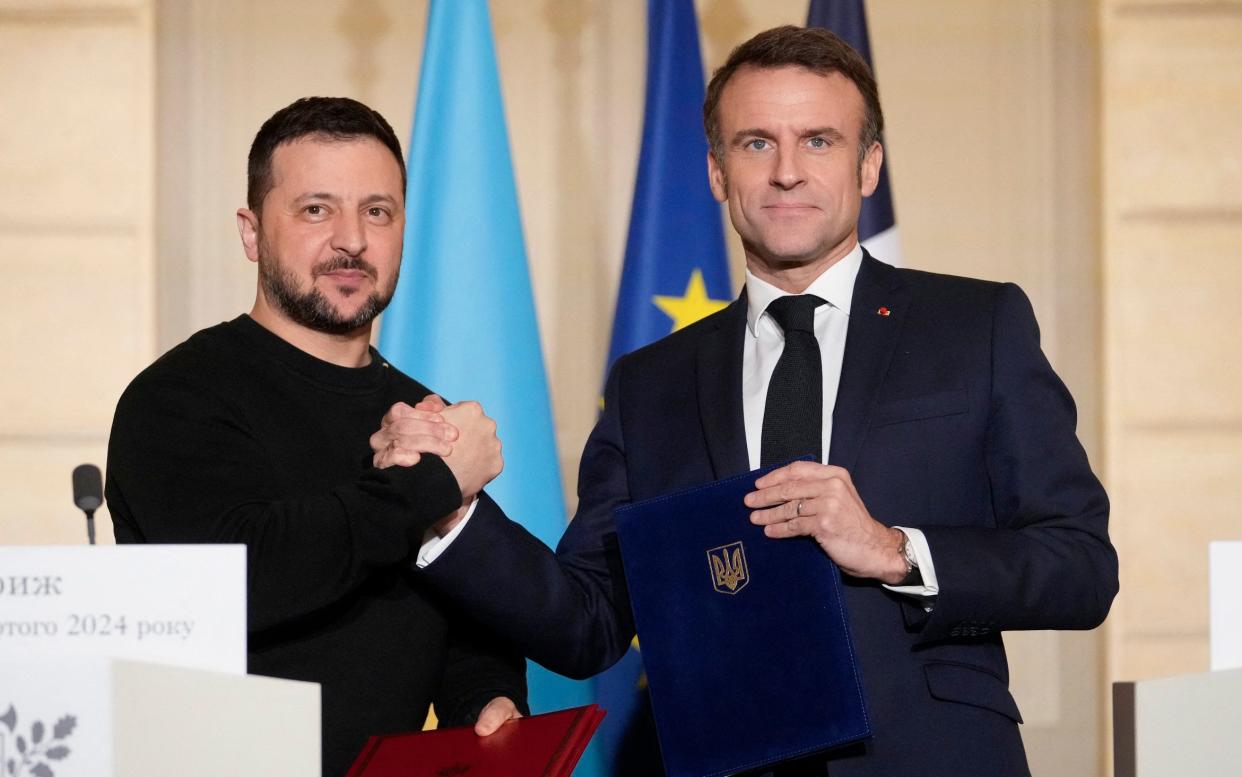The weakened West stands no chance against resurgent Russia

- Oops!Something went wrong.Please try again later.
More ammunition. More drones. And perhaps a few more tanks and aircraft. There are many things Ukraine will need if it is to stand up to Putin’s aggression, and restore its territory.
But Europe appears to have a different solution to the threat from Russia, one that involves much more debt. France is leading a drive for the EU to issue a fresh round of emergency bonds to pay for re-arming the Continent.
This would be extremely short-sighted. A new Cold War may last for decades, just as the last one did, and it will have to be paid for with real cash, not fiddly bond issues. Europe’s broken economies, including our own, cannot afford to stand up to Putin – and until we take the difficult choices needed to fix it, the Continent is in danger.
After more than two years of brutal conflict, Russia and Ukraine are locked in a war of attrition, with both sides sustaining mounting losses of both men and equipment.
Over the last few months, two points have become painfully clear. A long war may play into Putin’s hands, with Russia’s greater depths of manpower and resources allowing it to eventually overwhelm its neighbour. And Putin won’t stop there.
After his electoral “victory” earlier this month, the dictator reminded Russians that they would never be “intimidated” by the West. He has been probing the Baltic States, which are sounding the alarm that Moscow poses an existential threat.
And what will be put in his way? More borrowing, apparently. France’s President Macron is leading a push for a common EU debt issue to pay for the re-arming of the continent, modelled on the €700bn (£601bn) it raised three years ago to pay for the bloc’s Covid recovery. It has the support of Spain and the Baltics, though Germany is adamantly opposed – perhaps aware it will end up with the bills.
Nonetheless, over the next few months, we can expect to see some form of plan cobbled together as EU nations grow increasingly concerned that US support for Kyiv could be withdrawn if Trump is elected later this year.
European armies have fallen into shabby disrepair, and a fresh round of debt to pay for arms for Ukraine and bolstering EU defence in general will be viewed by many as the simplest solution.
But hold on. That is crazy. Even leaving aside the typically shameless self-interest of the French – after all, let’s keep in mind that as Europe’s largest defence manufacturer most of the money raised will be spent with its companies – standing up to Vladimir Putin can’t be financed by debt.
Europe, with the UK as guilty as anyone, took the peace dividend from the end of the Cold War and spent most of it on welfare. The decline in defence spending as a percentage of GDP has been dramatic across the Continent.
In France, defence spending as a percentage of GDP has fallen from 5.4pc of GDP to 2.8pc in 1990 and just 1.8pc today. In Germany, it has fallen from 3.7pc of GDP in 1960 to 1.4pc today. In Italy, it has fallen from 2.7pc of GDP to 1.5pc today, while in the UK, it has fallen from 7pc of GDP in 1960 to 2.2pc now.
It is not just about percentages. Europe’s high-tax, high-regulation, high-welfare model has also resulted in permanent economic stagnation. We spend less of our GDP than ever on defence, and GDP overall is declining in many nations.
Put those two factors together, and it is not hard to understand why we don’t have the resources to give Ukraine the help it needs, or to equip the armed forces that are strong enough to deter aggression.
A new form of debt is not going to fix that. There are two big problems. First, a new Cold War is not a one-off emergency. The last one ran for decades, and this one may well do so as well. It is not like bailing out the banks, or paying for Covid. Nor is it like the previous Cold War, during which period defence spending across major European powers gradually fell.
In all likelihood, containing rising global threats will require sustained spending over the next few decades, meaning we will need to commit real resources, not simply put it on the collective credit card.
Second, and perhaps more importantly, yet more debt will only weaken European economies even further. We have already seen extraordinary rises in debt to GDP ratios, particularly in France and Italy. Borrowing too much and living beyond our means is part of the problem. It is not going to be part of the solution.
Some military experts are now warning that, even in the Nato era, defence spending across Europe will need to rise to around 4pc of GDP.
It won’t just be a case of salami slicing elsewhere, we require radical reform of the social democratic welfare model, putting countries on a path to sustainable growth. That will involve difficult decisions which many Western politicians have been too eager to duck.
Right now, Europe’s broken economies are too financially weak to stand up to a resurgent Russia, or to its far more threatening ally China.
The price of that weakness may be very high, and the last thing we should do is delude ourselves that we can fix the challenge with yet more debt. That will only make us weaker, and more vulnerable, than ever.

